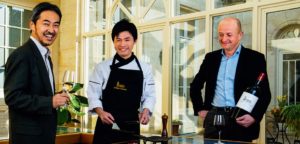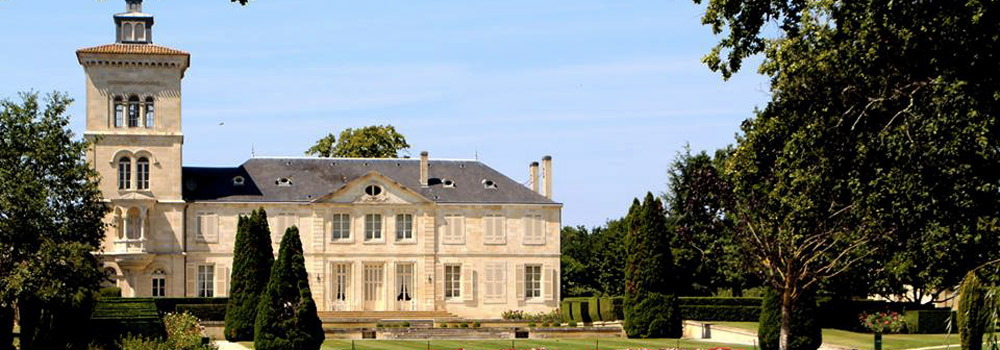Welcome to our Château Lagrange. Discover its history, its greatest vintages and its tasting notes.
THE STORY OF A SUPERB WINE
In order to understand its history, we dedicate this article to Château Lagrange in the Saint-Julien AOC since 1842. Château Lagrange, known as "La maison noble de Lagrange Monteil" in medieval times, has a rich history. The Château was shaping its history long before 1842, but we're going to focus on its history after that date, as it's complex to trace the owners back to medieval times.
- In 1842, the Château became the property of Compte Tanneguy Duchâtel, Minister of the Interior and member of the Académie des Beaux Arts. From 1842 to 1874, the Count made a major contribution to the estate's reputation throughout Europe. At that time, the estate covered 280 hectares, including 120 hectares of vines, with a relatively average production of 200 barrels. It was under the account's ownership that Château Lagrange was classified 3rd Grand Cru de Saint Julien in the 1855 classification. In the same year, the account became the forerunner of vineyard drainage. Following this success, he plans to set up a small drainage factory and pottery tube factory. His son succeeded him, and the Château remained in the family until 1875.
- In 1976, the Château passed into the hands of the English colonialist Muicy Louys, but the succession did not take place under ideal conditions for the Château. The estate suffered from "phylloxera" and "mildew", which weakened it enormously. Thanks to its large surface area, the estate barely survived the various epidemics.
- In 1918, the Grand Cru de France real estate company (at the time already owner of Châteaux Brane Cantenac and Issan) bought the estate for 12 million francs.
- The Château changes hands once again, and is bought by Manuel Cendoya (winemaker) and José Telleria (industrialist). Unfortunately, the Château experienced its dark years. Poor economic conditions had an impact on the wine trade. What's more, terrible weather forced the two Spanish Basques to downgrade their harvest. To restore their financial health, they decided to sell off the estate's outlying plots to neighbors. Despite these financial benefits, Château Lagrange lost its prestige and slowly died out, with only 157 hectares, including 56 hectares of vines.
- After this dark period for the Château, the Suntory group (Japan's leading drinks and spirits company) bought the Château in 1983. To ensure that the estate was reborn as prestigious as before, if not more so, the Suntory giant didn't hesitate to pull out all the stops. The famous oenologist Emille Peynaud soon became the estate's advisor, a position he held for 6 years. In addition, with the advice of Michel Delon for the first 10 years and a team under the direction of Marcel Ducasse, the ambitious rebuilding of the estate became feasible.
After twenty years of hard work, technical and human investment, the estate has regained its prestigious character and produced an elegant, perfectly balanced wine of the kind you can find today.
Today, the estate is eis now in the hands of Matthieu Bordes and Keiichi Shiina, both intent on pursuing this quest for excellence. In order to preservever its history, the estate has the potential to evolve with the greatest possible respect for the environment, aiming to reduce the property's ecological footprint.
After having passed from hand to hand and having lived through some dark episodes, Château Lagrange is now the largest vineyard in the appellation, with 118 hectares of vines. Revenge for the dark years. Today, Château Lagrange stands out for its history and values, enabling it to offer a unique wine experience.
OUR SELECTION OF CHÂTEAU LAGRANGE'S FINEST VINTAGES
We've selected a number of vintages considered to be some of Château Lagrange's finest. Of course, it's up to each individual to form his or her own opinion and consequently his or her own ranking according to personal preferences. Nevertheless, we hope this guide will help you in your search.
Many tasters confide that Château Lagrange remains stable and relatively consistent from bottle to bottle. The wines are colorful, aromatic, full-bodied and very well-balanced, with a tannic finish that is always coated and tasty.
-
Château Lagrange 1990
Weather conditions:
A wet and cool April. 1990 A dry year until the harvest. Rain only appeared on September 22, after the harvest. Temperatures were high, well above normal.
Tasting notes:
" At once massive, richly extracted, generously woody and spicy, the 1990 Lagrange sports a dark purple color and unfurls abundant jammy fruit in stages, underpinned by low acidity and copious tannins. The whole, very glyceric and massive, expresses an unctuous palate and certainly seduces the taster." Robert PARKER
-
Château Lagrange 1996
Weather conditions:
A hot, dry spring followed by a similar summer. A few thunderstorms caused some millerandage (failure of the vines to ripen, leading to partial abortion of the grapes) on the Merlot. late August to mid-September: plenty of sunshine. An extremely beneficial period that marked the vintage. The Merlots were picked in excellent conditions, while the Cabernets Sauvignon enjoyed dry weather.
Tasting notes:
"A great wine with the scent of blackberry syrup, pure expression, a benchmark nose for freshness, then complexity. Constantly evolving in the glass. Superb balance of mellowness and softness, despite its great energy. Top-of-the-range tannicity. A superb palate for lovers of fine Cabernet Sauvignon. Great finish. A must from the Château. Jean-Marc QUARIN
-
Château Lagrange 2000
Weather conditions:
Plenty of rain and sunshine during the spring preceding the harvest. As a preventive measure, the vineyards were treated against mildew. This was followed by a rapid and relatively even flowering. A summer of contrasts, with cool, wet July and hot, dry August and September, made a major contribution to the success of the vintage.
Tasting notes:
"Intense, dark red color. Superb nose, fruity, fresh, ripe, with hints of cedar. Subtle. Dense on the attack, then mellow and fresh, the wine melts in the mouth with grace and superb balance. It finishes savory and long, with perfectly coated tannins. A great wine! Jean-Marc QUARIN
-
Château Lagrange 2005
Weather conditions:
2005 was a very dry year in Gironde, with very little rain and lots of sunshine. This vintage will live long in the memory of every winegrower, thanks to its outstanding weather conditions.
Tasting notes:
"This wine is deliciously different from the other great vintages of the cru, due to its Merlot dominance in the blend. Colorful, aromatic, it offers a regal palate with flavor, power, and a rather exceptional medium. Melting yet tannic, it finishes very long and aromatic. Compared to the 2000, the 2005 surpasses it." Jean-Marc QUARIN
-
Château Lagrange 2009
Weather conditions:
2009 was neither a hot nor a dry year. Warm weather contrasted with showers arrived just when the vines needed it. Weather conditions in August, September and October were perfect for the vines.
Tasting notes:
"Dark, intense, beautiful color. Fine, fruity, ripe nose, with hints of cherry and a suave, floral touch. Beautiful, rich, luscious entry on the palate, where the wine develops aromatically, with taste, body, power and fine tannins. Rich, flavorful, full-bodied too, it finishes long and sappy, with Cabernet Sauvignon tannins. Excellent aromatic length, with notes of flowers and ink. In my opinion, this wine will surpass the 2005 (predominantly Merlot) thanks to a very different blend (predominantly Cabernet-Sauvignon)". Jean-Marc QUARIN
-
Château Lagrange 2010
Weather conditions:
In 2010, climatic conditions were rather surprising and unusual, combining dryness and coolness. Nevertheless, exceptional sunshine shone from May to the end of October. The drought caused a late harvest in 2010. This vintage is renowned for its finesse and pronounced concentration of tannins.
Tasting notes:
" To say the least, this wine is not under-extracted, a criticism I would level at many 2010s. On the contrary, Lagrange has not hesitated to take a lot of substance from the reasons. The result is a wine with a fine nose, a pulpy start, a very dense middle and a tannic finish that's much tighter than usual, but with fruit and tannin wrapped around it. It's a gamble that will pay off at the end of the ageing process. Jean-Marc QUARIN
You can find all our old vintages of Château Lagrange on our website!





![✨ Comptoir des Millésimes honors Champagne's great winemakers ✨[LINK TO THE ORGANIC CELLAR]We've selected 11 exceptional estates that reveal the full richness of Champagne terroir through unique, refined cuvées. Hugues Godmé - In Verzenay, this family-run biodynamic estate offers precise, vibrant champagnes with a beautiful mineral tension.Egly-Ouriet - A benchmark for the Montagne de Reims, its powerful champagnes, aged for long periods in barrel, impress with their complexity.Moussé Fils - In Cuisles, the Meunier grape is king. Pertois-Moriset - Pure, taut Chardonnay Grands Crus for lovers of chalky finesse. A fine address in Mesnil-sur-Oger.Geoffroy - In Aÿ, this domaine produces fine champagnes, carefully crafted and barrel-aged to reveal the full complexity of the terroir.Larmandier-Bernier - Biodynamic viticulture, exceptional parcels and purity. Crystal-clear, intense champagnes for connoisseurs.Roger Coulon - Eight generations of expertise at Vrigny. Balanced, subtle and elegant champagnes.A. Bergère - In Avize, a dynamic house offering expressive, fruity and accessible cuvées.Adrien Renoir - A promising talent from Verzy, he produces fine, complex champagnes with a true sense of terroir.De Sousa - Emblematic house in Avize. Richness, depth, long ageing: Chardonnay at its peak.Pierre Paillard - In Bouzy, the family magnifies Pinot Noir with vinous, racy and sincere cuvées.📦 Order now on our website#ComptoirdesMillésimes #Champagne #VigneronsIndépendants #GrandVin #ChampagnesdeTerroir #LivraisonRapide](https://www.comptoirdesmillesimes.com/blog/wp-content/plugins/instagram-feed/img/placeholder.png)